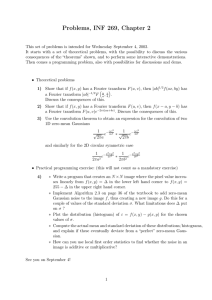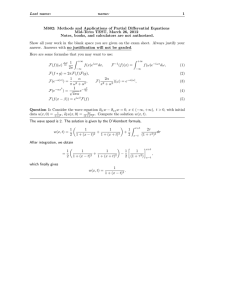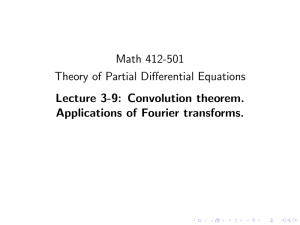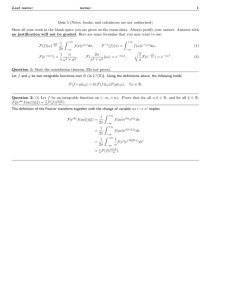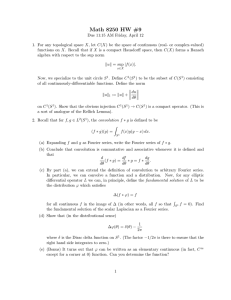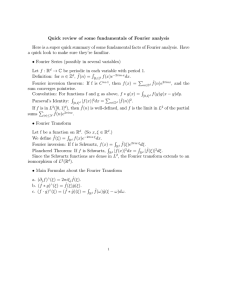Last name: name: 1 Quiz 5 (Notes, books, and calculators are not authorized)
advertisement
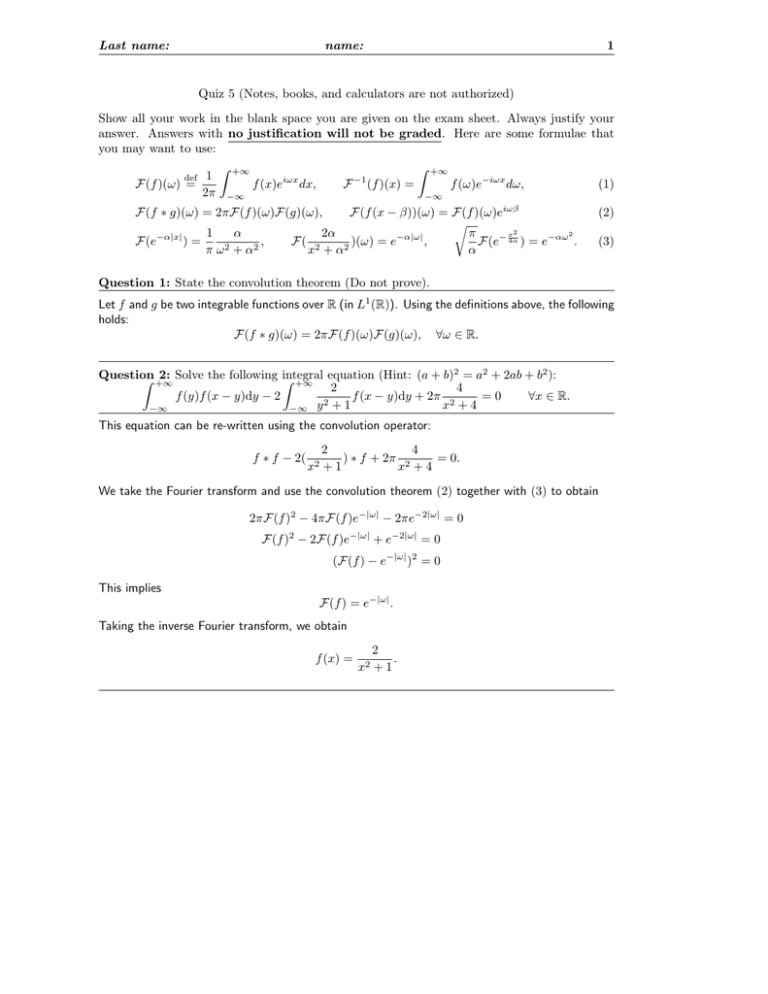
Last name: name: 1 Quiz 5 (Notes, books, and calculators are not authorized) Show all your work in the blank space you are given on the exam sheet. Always justify your answer. Answers with no justification will not be graded. Here are some formulae that you may want to use: Z +∞ Z +∞ def 1 f (x)eiωx dx, F −1 (f )(x) = f (ω)e−iωx dω, (1) F(f )(ω) = 2π −∞ −∞ F(f (x − β))(ω) = F(f )(ω)eiωβ r 2 x2 2α π −α|ω| F( 2 )(ω) = e , F(e− 4α ) = e−αω . 2 x +α α F(f ∗ g)(ω) = 2πF(f )(ω)F(g)(ω), F(e−α|x| ) = α 1 , π ω 2 + α2 (2) (3) Question 1: State the convolution theorem (Do not prove). Let f and g be two integrable functions over R (in L1 (R)). Using the definitions above, the following holds: F(f ∗ g)(ω) = 2πF(f )(ω)F(g)(ω), ∀ω ∈ R. 2 2 2 Question 2: Solve the following integral Z +∞ Z +∞ equation (Hint: (a + b) = a + 2ab + b ): 4 2 f (x − y)dy + 2π 2 =0 ∀x ∈ R. f (y)f (x − y)dy − 2 2+1 y x +4 −∞ −∞ This equation can be re-written using the convolution operator: f ∗ f − 2( 2 4 ) ∗ f + 2π 2 = 0. x2 + 1 x +4 We take the Fourier transform and use the convolution theorem (2) together with (3) to obtain 2πF(f )2 − 4πF(f )e−|ω| − 2πe−2|ω| = 0 F(f )2 − 2F(f )e−|ω| + e−2|ω| = 0 (F(f ) − e−|ω| )2 = 0 This implies F(f ) = e−|ω| . Taking the inverse Fourier transform, we obtain f (x) = 2 . x2 + 1 2 Quiz 5, October 2, 2013 Question 3: State the shift lemma (Do not prove). Let f be an integrable function over R (in L1 (R)), and let β ∈ R. Using the definitions above, the following holds: F(f (x − β))(ω) = F(f )(ω)eiωβ , ∀ω ∈ R. Question 4: Use the Fourier transform technique to solve ∂t u(x, t) + t∂x u(x, t) + 2u(x, t) = 0, x ∈ R, t > 0, with u(x, 0) = u0 (x). Applying the Fourier transform to the equation gives ∂t F(u)(ω, t) + t(−iω)F(u)(ω, t) + 2F(u)(ω, t) = 0 This can also be re-written as follows: ∂t F(u)(ω, t) = iωt − 2. F(u)(ω, t) Then applying the fundamental theorem of calculus we obtain 1 log(F(u)(ω, t)) − log(F(u)(ω, 0)) = iω t2 − 2t. 2 This implies 1 2 F(u)(ω, t) = F(u0 )(ω)eiω 2 t e−2t . Then the shift lemma gives 1 F(u)(ω, t) = F(u0 (x − t2 )(ω)e−2t . 2 This finally gives 1 u(x, t) = u0 (x − t2 )e−2t . 2


